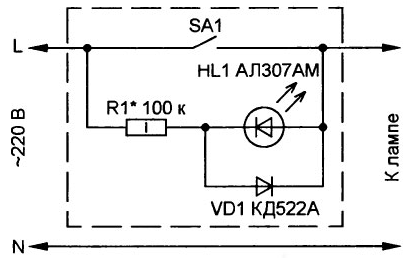
|
|
ENCYCLOPEDIA OF RADIO ELECTRONICS AND ELECTRICAL ENGINEERING Elimination of flickering of the fluorescent energy-saving lamp. Encyclopedia of radio electronics and electrical engineering
Encyclopedia of radio electronics and electrical engineering / Lighting A switch with a glowing open contact indicator is poorly compatible with a modern fluorescent energy-saving lamp. The switch indicator causes short intermittent flashes (flashing) of the lamp. This problem is usually solved by removing the indicator, which causes another problem: a switch without an indicator is difficult to find in the dark. The article proposes a very simple technical solution that eliminates the flashing of the lamp.
In many residential and industrial premises, switches with luminous indicators are installed. Such an indicator, connected in parallel with the contacts of the switch, makes it easier to find it in the dark. It contains a current-limiting resistor R1 and a neon lamp HL1 (Fig. 1) or an HL1 LED protected from reverse voltage by a VD1 diode (Fig. 2). Together with incandescent lamps, such an indicator works remarkably - with the contacts of the switch SA1 open, the current, limited by the resistor R1 to the level of fractions of milliamps, flows through the indicator, causing it to glow, and through the lamp, without having any effect on it. When replacing an incandescent lamp with a modern fluorescent energy-saving one, the switch indicator disrupts the normal operation of such a lamp, turning it into a relaxation generator. The current flowing through the indicator charges the lamp rectifier filter capacitor. When the capacitor reaches the start voltage of the voltage converter, the lamp lights up, the capacitor quickly discharges, the lamp goes out, and then the process repeats. Visually, it looks like a flash. Due to the irritant effect, many users turn off the indicator or install a switch without an indicator. You can eliminate the flashing of a fluorescent lamp in a very simple way: by shunting it with a capacitor C1, as shown in Fig. 3. The reactance of this capacitor at a frequency of 50 Hz is ten times less than the resistance of the current-limiting resistor R1. This resistor forms a mains voltage divider with the capacitor. The voltage on the capacitor C1 with the contacts of the switch open is not enough to ignite the lamp. When the switch contacts are closed, capacitor C1 is under full mains voltage, additionally filtering the interference generated during the operation of the voltage converter of the energy-saving lamp.
Capacitor C1 is most conveniently installed at the point where the lamp is connected to the electrical wiring of the apartment. The most reliable are capacitors from a mains filter of imported equipment, which are specially designed for inclusion in an alternating current circuit, as evidenced by the marking "AC". It is this capacitor that corresponds to the nominal alternating voltage of 250 V, shown in Fig. 3. Domestic K73-17 with a rated voltage of 630 V and BMT-2 are somewhat worse.
The capacitance of the capacitor depends on the current through the indicator - for small-sized neon lamps, a BMT-2 capacitor with a capacity of 0,047 microfarads with a nominal voltage of 400 V turned out to be enough. They work reliably under mains voltage. Even more reliable, these capacitors and the K73-17 mentioned above operate on a pulsating voltage, as shown in fig. 4.
On fig. 3 shows an indicator on a neon lamp as a possible option, it can also be an indicator on an LED. For a home-made indicator, any glow discharge lamp HL1 in fig. 1 or any low-power LED of the visible radiation spectrum HL1 in fig. 2. Diode VD1 (Fig. 2) - any low-power silicon universal or pulsed. The resistance of the current-limiting resistor R1 is selected according to the desired brightness of the radiation of the element HL1, but the amplitude of the current through HL1 should not reach the maximum allowable value. If the flashing of the fluorescent lamp has not been eliminated, it is necessary to increase the capacitance of the capacitor C1 (Fig. 3) or capacitors C1 and C2 (Fig. 4), their capacitance must be the same. Author: K. Moroz
Machine for thinning flowers in gardens
02.05.2024 Advanced Infrared Microscope
02.05.2024 Air trap for insects
01.05.2024
▪ Honeywell pressure sensor in SMD version ▪ Cutlery affects the taste of food ▪ New generation of 8-bit microcontrollers
▪ section of the site Electrical safety, fire safety. Article selection ▪ Volyapyuk's article. Popular expression ▪ article What is quantum theory? Detailed answer ▪ article Use of technical teaching aids. Standard instruction on labor protection ▪ article Many-sided picture. Focus Secret
Home page | Library | Articles | Website map | Site Reviews www.diagram.com.ua |






 Arabic
Arabic Bengali
Bengali Chinese
Chinese English
English French
French German
German Hebrew
Hebrew Hindi
Hindi Italian
Italian Japanese
Japanese Korean
Korean Malay
Malay Polish
Polish Portuguese
Portuguese Spanish
Spanish Turkish
Turkish Ukrainian
Ukrainian Vietnamese
Vietnamese




 Leave your comment on this article:
Leave your comment on this article: